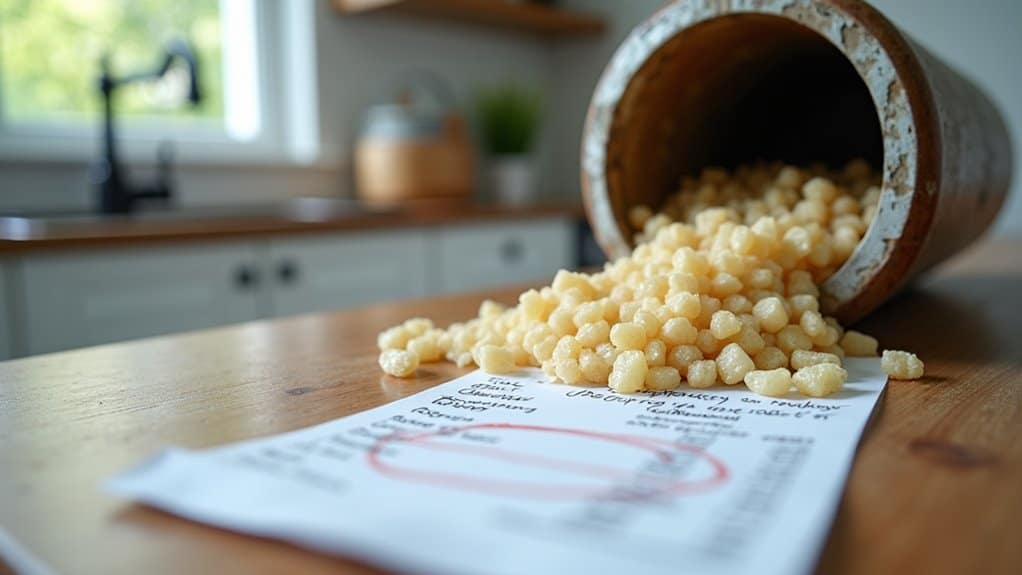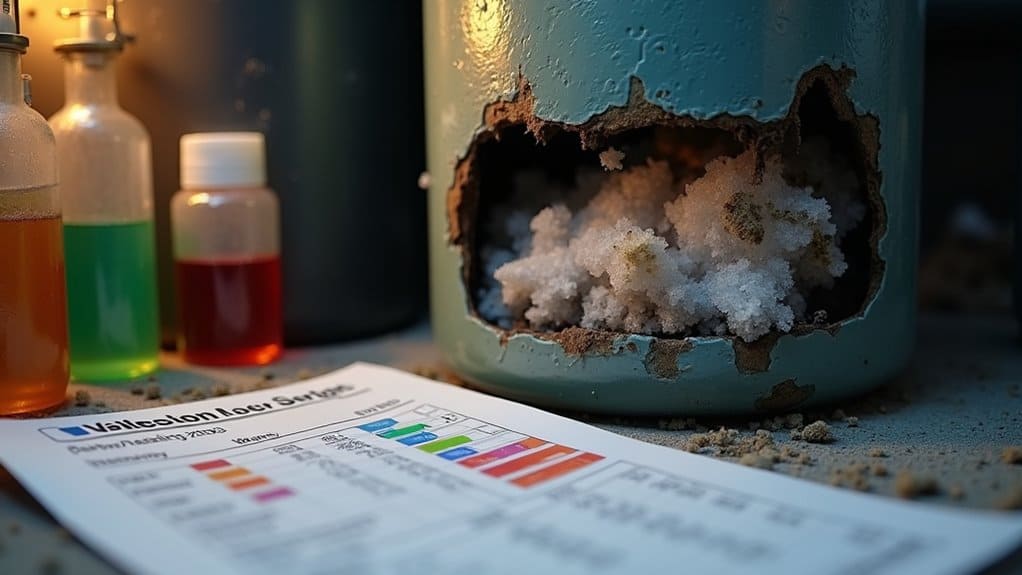When shopping for water softeners, we’ve found salespeople often gloss over crucial maintenance requirements. They won’t mention monthly salt checks, regular cleaning of brine tanks, or resin replacement costs that can reach $400. Your salt budget will likely be $150-$300 annually—much higher than quoted. Most concerning is the venturi valve issue that can silently kill your system. These hidden truths could save you significant money and frustration down the road.
Key Takeaways
- Regular maintenance is required despite “set it and forget it” sales pitches, including monthly salt checks and annual cleaning.
- Salt consumption for a family of four can reach 40 pounds monthly, costing $150-$300+ annually.
- Resin replacement is a significant hidden expense, costing $200-$400 for professional service.
- Venturi valve failures cause major system problems but aren’t typically disclosed during sales presentations.
- Most dealers don’t mention that proper system maintenance requires specialized knowledge and potentially professional annual service.
The Hidden Maintenance Schedule They Don’t Advertise

While many water softener companies tout the “set it and forget it” convenience of their systems, they often gloss over the regular maintenance these appliances actually require.
The truth? You’ll need to check salt levels monthly, clean brine tanks 1-2 times yearly, and service resin tanks every 6-12 months. Salt bridges require monitoring every 3-6 months. Neglecting these maintenance tasks can lead to system inefficiency and higher energy bills over time. Additionally, neglected maintenance tasks can significantly reduce the lifespan of your water softener.
What they won’t tell you: brine tanks need full disassembly to properly clean salt residue. Bridge removal involves physical scrubbing that risks damaging components, and resin beds require specialized cleaners.
Most companies recommend annual professional service—a detail conveniently omitted during sales pitches.
Why Your Salt Budget Will Be Higher Than Expected

Despite what salespeople often claim, your water softener will consume significantly more salt than initially estimated, creating an ongoing expense many homeowners overlook. A typical family of four can use up to 40 pounds of salt each month—far more than the “occasional bag” mentioned during sales pitches. Water softeners require salt with a 99.5% purity rate for optimal performance of the system. Additionally, many homeowners are unaware that system inefficiencies can further exacerbate the salt consumption issue.
| Factor | Low Estimate | High Reality |
|---|---|---|
| Monthly Usage | 20-30 lbs | 40-60 lbs |
| Annual Cost | $60-100 | $150-300+ |
| Replacement Frequency | “Every few months” | Monthly for many |
System inefficiencies compound these costs. Timeclock systems use twice as much salt as demand-driven units, while water hardness levels can double consumption rates in certain areas.
The Truth About Resin Replacement Costs

Water softener manufacturers rarely advertise the inevitable expense of resin replacement, yet it represents one of the most significant maintenance costs you’ll face. Additionally, the lifespan of resin can vary greatly depending on water quality and usage.
When your system needs rebedding after 10-15 years, expect to pay $200-$400 for professional service, while DIY options range from $147-$300. The savings are substantial compared to contractor rates of $45-$150 per hour.
System size matters—whole-house units require more resin (typically 1 cubic foot at $50-$400 depending on quality). Many homeowners choose to use Aldex Resin options for their high-quality and reliability when replacing their existing system.
Pre-packaged kits start at $159, but savvy homeowners can find discounted resin at $36.69 per quarter cubic foot after promotions.
Venturi Valve Issues: The Silent System Killer

Beyond those visible resin costs lies another component that could be silently destroying your water softener right now—the venturi valve.
This crucial part creates the vacuum needed to draw brine into your resin bed during regeneration. When it fails, you’ll notice excess water in your salt tank and persistent hard water issues despite adding salt. Quality water softeners can help mitigate these problems by ensuring more efficient operation.
Common culprits include mineral buildup, clogging, or misaligned gaskets. When troubleshooting, you should check for suction at the port after removing the bypass to determine if the venturi is functioning properly.
We recommend regular inspection—blow air through the venturi hose to check for obstructions and clean with non-metal tools to avoid damage.
Don’t ignore these symptoms. A failing venturi leads to wasted salt, ineffective softening, and eventually, complete system failure.
Frequently Asked Questions
Can Water Softeners Cause Damage to Specific Plumbing Fixtures?
Yes, water softeners can damage chrome fixtures, accelerate corrosion in copper or lead pipes, and degrade anode rods in water heaters if we don’t properly maintain and calibrate them.
How Do Softeners Affect Municipal Water Treatment Systems?
We’re contributing to a serious issue – our home softeners discharge chloride-laden brine that treatment plants can’t remove. This increases toxicity in waterways, corrodes infrastructure, and creates costly regulatory challenges for municipalities.
Do Water Softeners Change Drinking Water Taste?
Yes, we’ll notice water softeners change taste, removing minerals that cause hardness. Many find softened water “cleaner” tasting, but it can feel slippery and initially unfamiliar until we adjust.
Are There Health Impacts From Consuming Softened Water?
We must be aware that softened water contains increased sodium, which may impact those with hypertension, kidney disease, or sodium-restricted diets. It also removes beneficial calcium and magnesium from our drinking water.
Can Softeners Handle Well Water With High Iron Content?
No, we don’t recommend standard softeners for high iron content. They’re only effective up to 1 ppm of ferrous iron and completely fail with oxidized iron, significantly shortening resin life and increasing maintenance costs.
Conclusion
We’ve found that water softener companies often gloss over the real ownership experience. They won’t volunteer information about monthly maintenance requirements, salt costs that can exceed $300 annually, resin replacement expenses every 5-10 years, or how venturi valve failures can destroy systems. Before purchasing, demand a complete cost breakdown and maintenance schedule. Taking time to research now will save you significant money and frustration later.

Craig “The Water Guy” Phillips is the founder of Quality Water Treatment (QWT) and creator of SoftPro Water Systems.
With over 30 years of experience, Craig has transformed the water treatment industry through his commitment to honest solutions, innovative technology, and customer education.
Known for rejecting high-pressure sales tactics in favor of a consultative approach, Craig leads a family-owned business that serves thousands of households nationwide.
Craig continues to drive innovation in water treatment while maintaining his mission of “transforming water for the betterment of humanity” through transparent pricing, comprehensive customer support, and genuine expertise.
When not developing new water treatment solutions, Craig creates educational content to help homeowners make informed decisions about their water quality.


